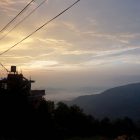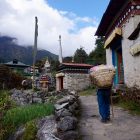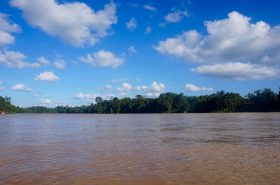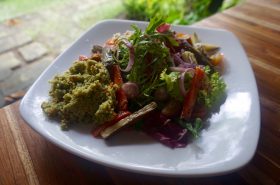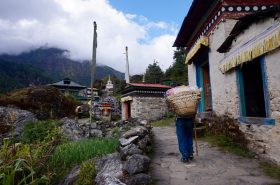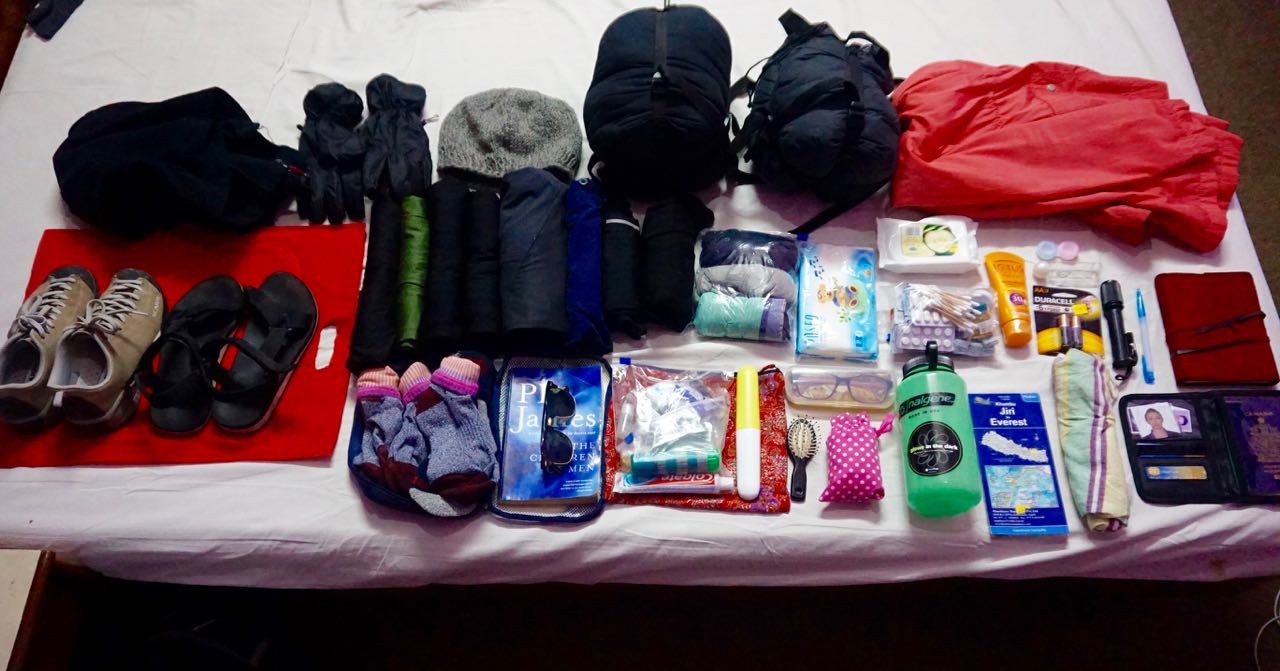
Here is a comprehensive list of all of the items that I packed for our 16 day trek in Nepal (plus 2 additional travel days) during October 2016.
Clothes
- Down jacket – this was rented from Shona’s in Thamel for 80 rupees/day.
- Light rain resistant/wind proof jacket – mine was NOT water proof but we were lucky having no heavy rain days.
- 1 light fleece sweater – You will wear this all of the time.
- Hiking shoes/boots – Mine were not waterproof and I was concerned about having no ankle support, however they were comfortable and light.
- Sandals – These are really nice to have for the tea houses when you want to wear something other than stinky hiking boots and they are a quick option for when you need to use a toilet in a hurry!
- 2 pairs of ‘trekking’ pants – I brought 1 pair of workout pants because they dry fast, breathe well, and are comfortable. I also purchased a cheap pair of trekking pants in Thamel for under 1000 NPR which were great for the colder, windier days.
- 1 pair of shorts – I only used shorts for the areas below Lukla. Once we moved higher up into the mountains, I wore pants all of the time.
- 1 pair of sleeping pants/leggins – I brought a thick lined pair of heavy tights to sleep in and they were perfect.
- 1 long sleeved ‘sleep’ shirt – I had a thick long sleeved top with a fleece lining that was warm enough. Remember, you may need to layer up and wear more depending on the temperatures and the warmth of your sleeping bag.
- 1 long-sleeved trekking shirt – I brought a work out shirt that I used to run in because it was comfortable and quick-dry.
- 2 short-sleeved trekking shirts – I used short sleeves for the lower parts of our treks. If you are beginning in Lukla, you may only need 1 short-sleeve and an additional long-sleeved top.
- 2 sports bras – Need I say more? When one is wet from sweat or from washing, have a spare.
- 7 pairs of underwear – Mine were very airy and light weight and were purchased specifically for trekking. They dry in a few hours and take up very little space (you could definitely get away with bringing 4-5 pairs).
- 4 pairs of socks – I brought 3 trekking socks and an additional warmer weather trekking sock for when I needed to double up.
- Baseball style hat – Great for protecting your face from the sun and keeping sweat from getting into your eyes. Make sure it can be easily folded and packed away. Purchased my ‘gortex’ fake North Face hat for 400 NPR.
Warm Weather Gear
- 3-season sleeping bag – We rented ours from Shona’s in Thamel for 100 NPR/day.
- 1 Pair of lined, wind-resistant gloves – Bought at Shona’s for 500 NPR.
- 1 lined toque – Bought in Thamel for 200 NPR.
- 1 neck warmer/face warmer – You can buy these everywhere. The well-known brand that sells them is called “Head Gear”, however, you can find tons of knockoffs that carry the same quality. Jonny bought his in Namche for 200 NPR.
Toiletries
- 1 Toothbrush and Toothpaste (100 g)
- 1 Mini hair brush (I stopped using this halfway through)
- 1 Deodorant stick
- 1 bar of soap
- 1 bottle of shampoo (75 ml) – This was maybe unnecessary since both my husband and I only washed our hair twice each and the soap could have done the basic job.
- 1 bottle of face lotion (25 ml)
- Contact case and small bottle of solution – I bought mini bottles to downsize on anything liquid.
- 10 tampons – More can be purchased in places like Namche Bazaar. Plan ahead and know when your ‘time’ will come because many small towns do not sell them or they do and rack the price up substantially.
- 4 extra contacts
- Nail Clippers
- Glasses and case
Electronics
- Wrist watch – knowing the time is important for many reasons (safety, planning your treks, etc.) but having an alarm on the watch is also important
- i-pod/music player – Jonny’s i-pod was useful because it can connect to wifi, plays music, takes pictures, and also provides the time.
- Mirrorless Sony camera – we purchased our camera before this trip knowing we would be taking amazing pictures, but we were also concerned about having something lighter and smaller. A mirroless camera was a good option.
- Batter charger with USB and mini USB ports – This is very handy as the higher you go up, the more expensive it is to charge electronics. Some places don’t offer charging even if you are willing to pay, so have some kind of back up.
Entertainment
- Playing cards – Sometimes you WILL be bored and playing cards will always help with that. It is worth the little extra weight.
- 6 die – We enjoy a game similar to Yahtzee so we also brought some die, so that we had some variety in the games available to us.
- A book – make sure it is something you have not started or hardly begun. There will be plenty of opportunity to read on your rest days.
First Aid Kit/Medications
- Bandaids
- Acetazolamide (40 tablets) – For altitude sickness.
- Ciprofloxacin (20 tablets) – For bacterial infections.
- Metrovidazole and Diloxanide Furoate (10 tablets) – To treat diarrhea
- Ibuprofin (10 tablets) – An anti-inflammatory for headaches
- Water purification tablets (50 tablets) – For the obvious reason
- Safety pins – We ended up needing these to hold our cheap trekking pants together. They were also useful for pinning underwear to hang dry on our backpacks.
- 1 pack of Halls – For sore throats at higher altitudes
Other
- Sunglasses
- A map of the area
- 1 notebook
- 2 pens
- Passport
- TIMS card – should be acquired prior to your trip from the Tourist Board outside of Thamel.
- Extra baggies – you can use these for all kinds of things; dirty laundry, protecting something from getting wet, putting your bar of soap in, organizing smaller items, putting food into for later consumption, etc.
- Sunscreen
- Toilet paper – we brought a whole roll plus an additional pack of tissues. I was skeptical that they would last us until the end, but we learned the ‘Nepali’ way of cleaning which ends up being better for the environment as it reduces waste.
- Wet wipes – We used these as an alternative to showering. Hot showers can cost up to 600 NPR, so it gets quite expensive. Having a quick full body wipe down is the cheaper alternative.
- Bug spray – We never used ours. There are very few pesky insects in the Himalayas
- Hand sanitizer – Very nice to have after using the restrooms in Nepal.
- Nalgene 1 litre water bottle – We both caved and spent 1500 NPR each on our water bottles. The real Nalgenes are very durable, BPA free, and safe to hold hot liquids. It is very nice to put boiling water in your water bottle and to use it as a way to warm your sleeping bag at night. Plus, the water is safe to drink the following morning!
- 1 carabiner – These are handy for all kinds of things. I would suggest bringing more since they are useful for connecting things to your pack such as wet laundry or for hanging your water bottle.
- 1 laundry bag
- A rain cover for your Backpack – Many bags come with one, but you can purchase one in Kathmandu or during the trek.
Food
- 1 jar of peanut butter – Yes, it was heavy and yes, it was worth it. We found that ordering breakfast foods without toppings was a lot cheaper (pancakes, chapattis, tibetan bread, toast or oatmeal), then we could just add our own peanut butter to flavor it.
- 1 package of tea – Ordering a cup of hot water is a lot cheaper than ordering tea. You can pay half the price for the hot water, then just add your own tea bag.
- Granola – this was great for snacking along the way especially during the longer days.
- Dried fruit – another handy snack for those long treks.
- 4 small chocolate bars – chocolate gets expensive in the Himalayas, and you WILL want it after a hard day of trekking.
(Food was not something necessary to bring, but we do not regret having brought our own snacks in order to save money, and to have some small comforts along the way).
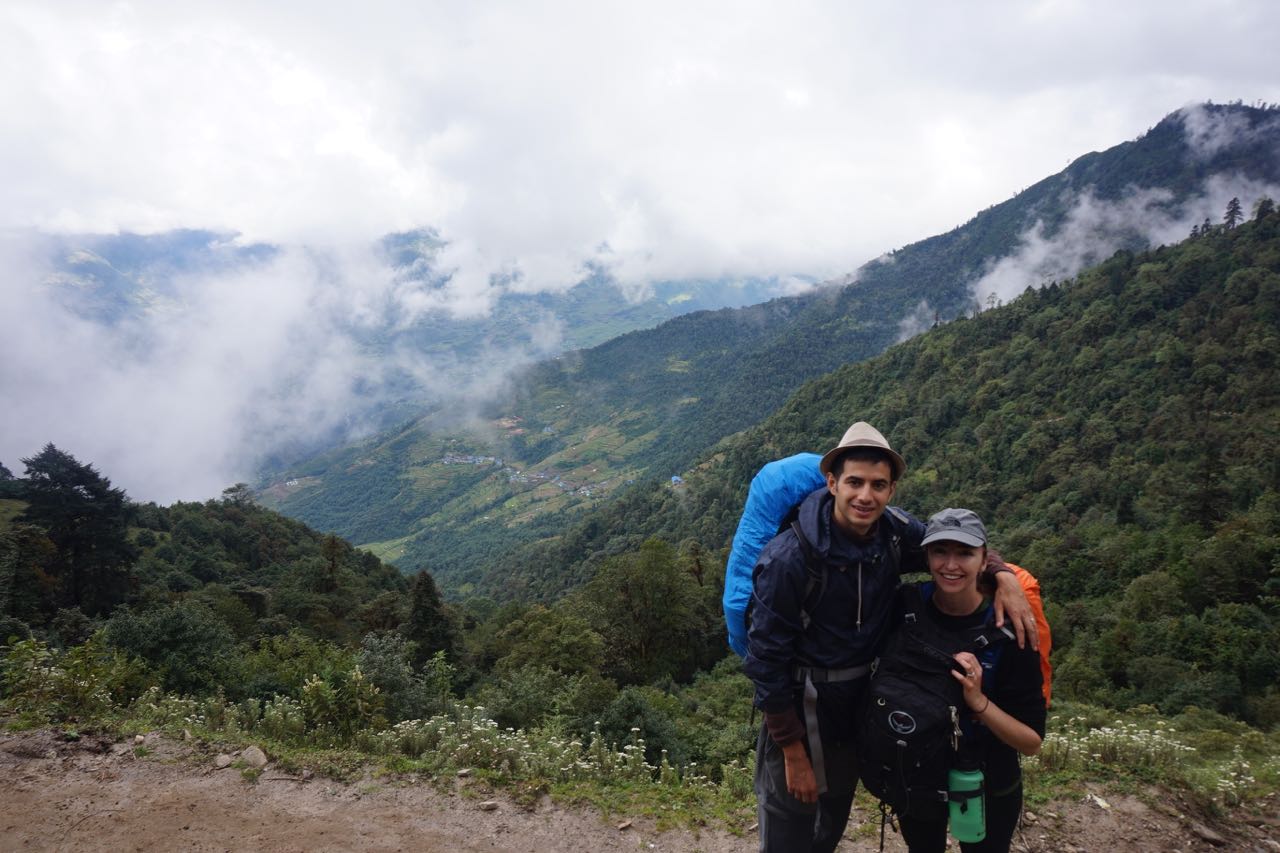
I hope this list has helped you decided what is necessary for an extensive trekking trip in a colder area. Some things to note are that Jonny and I went trekking during October right after the monsoon season in Nepal. What you bring during a warmer or colder time of the year will likely change.
Also, the list above included items that I had in my backpack, Jonny of course had his own bag with his own personal items. I carried all of our toiletries and the First Aid Kit which we of course shared between us. I could not fit my down jacket into my bag, so Jonny had to carry it in his. My bag was 33 litres which is a lot smaller than what most people seem to have had on their backs. Jonny had a 38 litre bag which was definitely a better overall size. Since our bags were fairly small in size, we ended up bringing a third 30 litre bag to carry our snacks and to distribute weight a little more. We did NOT need it though and could have just stuck with the two main bags and scrapped the snacks. I would not recommend carrying a third bag since it often needs to be carried in the front, and can obstruct your view making it difficult to know where to step.
Lastly, we packed light because we had to carry everything that we brought. We did not use a porter during the entirety of our trek, so that helped us minimize and bring only the essentials. Remember, it is a trek, not a beauty contest. Choose comfort over fashion, and remember that layering is key! You will be amazed at how little you need, and I guarantee that you will feel so much more free knowing that you’ve left all of those unnecessary items behind.
